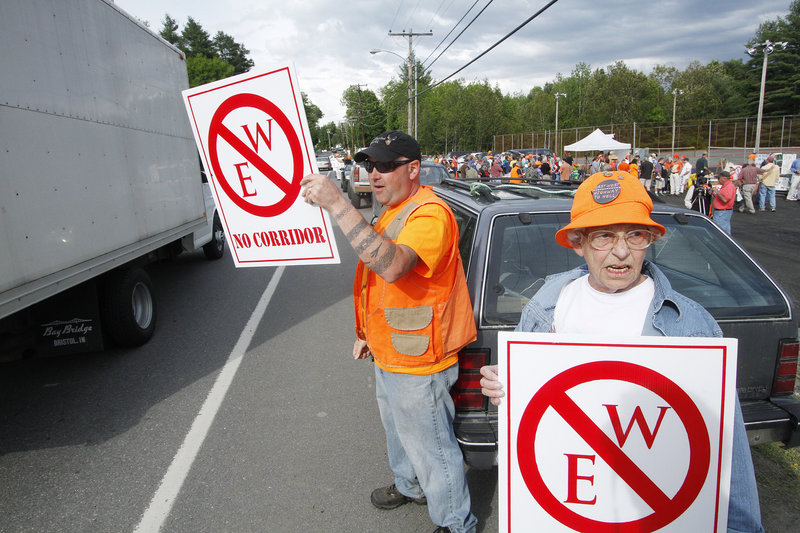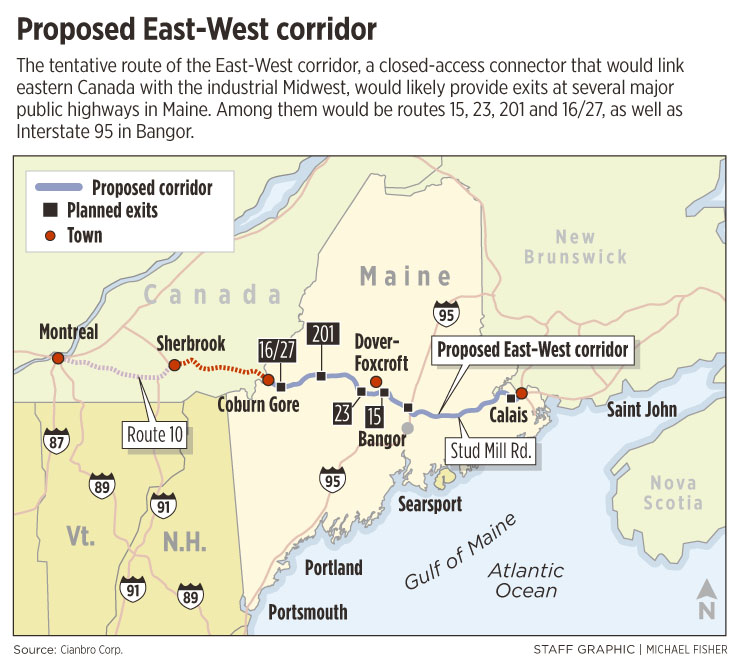DOVER-FOXCROFT – A transportation corridor running through central Maine to connect the Canadian Maritimes with Montreal, Toronto and the Midwest offers the best hope for an economic revival in rural communities from Washington to Franklin counties, supporters of a proposed East-West Highway said here Thursday evening.
“If you have a better idea of how to improve the economy of this state, please give it to me,” Peter Vigue, chairman and CEO of Cianbro Corp., told the 700 or so people who packed the gym at Foxcroft Academy.
Vigue, whose company is taking the lead in promoting the $2 billion proposal, was responding to opponents who sometimes heckled him during a question-and-answer period that followed his one-hour presentation on the controversial plan.
Vigue’s plan calls for a 220-mile, private toll road stretching from Calais to Coburn Gore, on its way to Montreal. It would be among the most expensive development projects in state history, paid for largely by investors and toll revenues. As a first step, a private consultant will conduct a feasibility study of the proposal, paid for by a $300,000 state loan championed by Republicans in the Legislature and supported by Gov. Paul LePage.
It also has the support of several business groups, including the Associated General Contractors of Maine. The group cited estimates that up to 2,000 direct and indirect jobs could be created just to build the road.
The East-West Highway proposal is the latest attempt to establish a cross-Maine transportation route, an effort that dates to the 1930s. Many business leaders and politicians believe Maine could benefit from a road that could provide a shortcut for Canadian goods moving between Maritime seaports and Quebec.
Detractors question whether the road would attract enough traffic to pay for itself, and whether it would receive a significant share of the economic benefit. They say the environmental impacts would be significant, and that upgrading an existing east-west rail line would be less intrusive.
The goal is to transform Maine into a trade gateway, rather than an obstacle to drive around. Supporters say the highway also would offer economic opportunities to struggling rural communities along the way, including Calais, Dover-Foxcroft and Jackman.
But local residents have many questions about the project, and Vigue attempted to answer some of them during the public meeting. Among his key points:
• The right of way for the project would not be 2,000 feet wide for its entire length, as some critics have contended. It would follow within an existing 2,000-foot-wide corridor in eastern Maine along the Stud Mill Road forestry haul road, then drop to 500 feet wide west of the Penobscot River. In all, the highway corridor would cover 13,250 acres.
• No oil pipeline, electric transmission lines or gas pipelines would be built within the right of way. The Stud Mill Road portion of the corridor already contains utility lines.
• No land would be taken by eminent domain.
• No conservation areas or protected areas would be bisected by the road.
But as he has in the past, Vigue declined to identify the precise route, except to say it would pass south of Dover-Foxcroft and north of Dexter. It would not go through any communities, he said.
“This is a work in progress and we are assessing every mile,” he said.
Vigue said developers hope to begin the design and permitting process in 2013.
Before Vigue’s presentation, roughly 150 protesters, many carrying signs and wearing blaze orange shirts and armbands, assembled outside the school. They lined the road across from Foxcroft Academy and gathered in a crowd across from the tennis courts, where several residents spoke against the proposal.
“We don’t want our way of life stamped out by one big footprint,” said David Lee Finley, a retired Dover-Foxcroft native.
The event was organized by a newly formed coalition of residents and local groups in Piscataquis and Penobscot counties called Stop the East-West Corridor. Its stated goal is to increase collaboration between groups around the state that are coming out against the proposed highway.
As they assembled, a long line was forming outside the gym as security officials began letting people inside.
Inside, opponents sat mainly in the bleachers, behind local residents who had come to learn more about the project or voice their support.
Because of the scale and scope of the project, opponents say the East-West Highway is shaping up to become one of the state’s landmark development battles, a legal and political tussle that could drag on for years.
Scores of opponents traveled to this town of 4,200 along the banks of the Piscataquis River to fire an opening shot in that pending battle.
The atmosphere was festive, with a folk guitar duo playing in the warm afternoon. Participants mingled, some wearing blaze orange T-shirts that read “Friends of the Hollow Middle,” an apparent reference to a statement attributed to Vigue about this rural section of Maine.
Other people carried signs, such as “Investors beware, rabble in roadway,” and “Don’t break the heart of Maine.”
“We’re giving up far too much real estate for far too few jobs,” said Bryant Brown, who owns 150 acres in Monson and fears the road would go by or near his home.
Staff Writer Tux Turkel can be contacted at 791-6462 or at:
tturkel@pressherald.com
Send questions/comments to the editors.





Comments are no longer available on this story